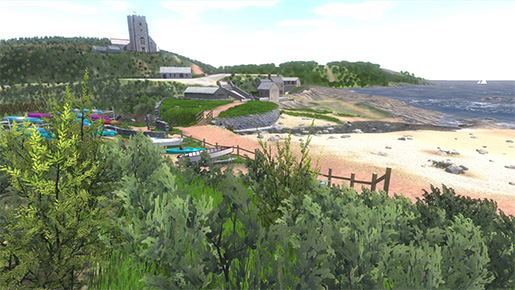 One highly unique – and very rewarding – line of research, both for the HIT Team and its postgraduate students, is addressing how to exploit virtual recreations of areas of natural beauty to help patients recover from traumatic incidents (including operations) and improve the well-being of other patients, from settings as diverse as Intensive Care Units to elderly care homes.
One highly unique – and very rewarding – line of research, both for the HIT Team and its postgraduate students, is addressing how to exploit virtual recreations of areas of natural beauty to help patients recover from traumatic incidents (including operations) and improve the well-being of other patients, from settings as diverse as Intensive Care Units to elderly care homes.
Research conducted since the late 1970s suggests that exposing individuals to natural environments, such as rural and coastal settings and smaller-scale urban areas with natural features (gardens, parks, etc.), can promote stress reduction, enhance mental recovery following tasks requiring high levels of attention, even reduce post-operative recovery times and the need for pharmaceutical pain relief. These “restorative environments” are now recognised as powerful tools in the treatment of a range of psychological conditions and a number of initiatives are being launched to encourage engagement with the natural environment to promote both physical and psychological wellbeing.

In collaboration with the Royal Centre for Defence Medicine (RCDM) and Queen Elizabeth Hospital (QEH), the Virtual Restorative Environment Therapy (VRET) project aims to exploit simulated restorative environments to deliver similar benefits to those individuals who are unable to access and experience real natural environments. Current work is based on two VR recreations of West Country beauty spots – Wembury Bay on the South coast of Devon and Burrator Reservoir on Dartmoor – and experiments are being conducted to evaluate individual’s responses to the simulated sights, sounds and smells of those recreations.
- Stone, R.J. (2012). “Human Factors Guidance for Designers of Interactive 3D and Games-Based Training Systems” (Second Edition); Human Factors Integration Defence Technology Centre Publication; February, 2012. Case Study 5. Depledge, M., Stone, R.J., & Bird, W. (2010). “Can Natural and Virtual Environments be Used to Promote Improved Human Health and Wellbeing?”; Environmental Science and Technology; 45(11); June; pp.4659-5064.
- Stone, R.J. (2012). “Virtual Reality for Post-Operative Restoration and Rehabilitation”; Clinical Front Line; Royal Centre for Defence Medicine; March.Knight, J.F., Stone, R.J., & Qian, C. (2012). “Virtual Restorative Environments: Preliminary Studies in Scene, Sound and Smell”; International Journal of Gaming and Computer-Mediated Simulations (IJGCMS); 4(3) – Ludica Medica Special Issue; July-September; pp. 73-91.
- Stone, R.J., Small. C., Knight, J.F., Qian, C., & Shingari, V. (2014). “Virtual Environments for Healthcare Restoration and Rehabilitation”; Part VI in Ma, M., Jain, L.C., & Anderson, P. (Eds.), “Virtual and Augmented Reality in Healthcare 1”; Intelligent Systems Reference Library Volume 68; 2014; Springer-Verlag: Heidelberg, Germany; pp. 497-521.